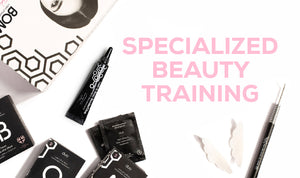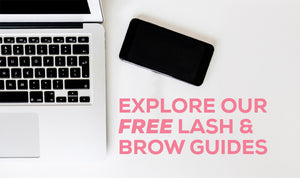Beautiful Brows & Lashes Blog
Lash Lift FAQs: All Your Clients’ Lash Lift Questions Answered
Welcome to our blog post on Lash Lift FAQs! If your clients are tired of using lash curlers and mascara daily, a lash lift might be the perfect solution. Professional lash lifts and tint kits have gained popularity in recent years as people have discovered lash lifts to be such convenient, low-maintenance alternatives to eyelash extensions.
Let's review some of clients' most frequently asked questions about lash lifts, from the process to how to care for their lashes afterward. Now, you'll be able to provide them with all the information they need to decide whether it's the right choice for them.
What is a lash lift, and how does it work?
A lash lift is a cosmetic procedure that enhances the appearance of natural lashes by giving them a lifted and curled look. It is an excellent option for those wanting longer-looking lashes without extensions or daily curling.
Using a specialized solution, a lash lift involves carefully perming and lifting your natural lashes from the root. Unlike eyelash extensions, which add volume and length by attaching synthetic lashes to your natural ones, a lash lift focuses on enhancing the natural lashes you already have.
Here's a step-by-step breakdown of how a typical lash lift procedure works:
- Preparation: Before the treatment begins, your lash technician will ensure that your eye area is clean from all traces of makeup. They may also ask about any allergies or sensitivities you may have.
- Shield placement: The technician will place silicone shields or pads along your lash line to protect your skin and prevent the lashes from sticking together. These shields or pads come in different sizes and shapes to accommodate different eye shapes and lift levels.
- Lash adhesive: The technician will apply a gentle adhesive to the back of the shields, securing them in place along your lash line. The lashes will also be glued to the silicone shield to be isolated before the lifting solution, the next step, is applied.
- Lifting solution: The technician will apply a lifting solution to your lashes. This solution softens and relaxes the lash structure, allowing the technician to mold them into the desired shape.
- Neutralizing solution: After the lifting solution has had time to process, a neutralizing solution will stop the lifting process and lock in the new shape of your lashes.
- Optional tinting: Your lash technician may offer to tint your lashes after lifting. This can add depth and definition to your lashes, making them appear darker.
- Removal & conditioning: Your technician will remove the shields, pads, and excess product. Then, they'll apply a moisturizer to nourish and strengthen your lashes.
The entire lash lift procedure usually takes 45 minutes to an hour, depending on the technician's skill and experience. It's relatively quick and painless, and you'll leave the salon with beautifully lifted lashes that last several weeks.
How long does a lash lift last?
On average, a lash lift can last from 6 to 8 weeks, but the longevity can vary depending on various factors:
Lash Growth Cycle
Since the lash lift works with your natural lashes, the treated lashes will eventually go through their growth and shedding cycle. As your natural lashes shed and new ones grow, the lifted effect will gradually diminish. Not all your lashes will shed simultaneously, so you may notice some variation in the lift as your lashes go through their growth cycle.
Aftercare
It's crucial to follow the aftercare instructions provided by your lash technician. These may include avoiding water and steam for the first 24 to 48 hours, refraining from rubbing or touching your lashes, and avoiding oil-based products that can weaken the lift. By following these guidelines, you can help prolong the lifespan of your lash lift.
Your Lifestyle & Habits
Your lifestyle and habits can also impact how long your lash lift lasts. Factors such as excessive rubbing or touching of your eyes, exposure to excessive heat or humidity, and using oil-based makeup or skincare products can all contribute to the gradual breakdown of the lift. Minimizing these factors can help extend the life of your lash lift.
Is a lash lift painful?
A lash lift is generally comfortable and painless. However, it's important to note that individual experiences may vary. You may feel a slight sensation during the procedure as the technician applies the lifting solution to your lashes. Some people describe this sensation as a gentle tingling or a mild tightening feeling. However, it should not be painful or uncomfortable.
Suppose you do experience any discomfort during the procedure. In that case, it's crucial to communicate with your lash technician so that they can make adjustments or address any concerns you may have. If you have susceptible eyes or are prone to allergic reactions, it's advisable to inform your lash technician beforehand. They may perform a patch test to check for any potential allergies or sensitivities to the products used during the lash lift.
Can you wear mascara or eye makeup after a lash lift?
After getting a lash lift, it's generally recommended to avoid wearing mascara or eye makeup for the first 24 to 48 hours. This allows the lifted lashes to set and maintain their shape without interference. The lifting and curling process may still be delicate during this initial period, and using mascara or eye makeup can weigh down or disrupt the lifted lashes.
Once the recommended time has passed, you can resume wearing mascara and eye makeup. However, many individuals find that they no longer need to use mascara regularly after getting a lash lift, as the lifted lashes already create the appearance of length and volume.
How do you care for your lashes after a lash lift?
By following these aftercare tips, you can help prolong the effects of your lash lift and keep your lashes looking lifted, curled, and beautiful. Consult your lash technician for personalized advice based on your lash characteristics and lifestyle. Here are some general care tips to follow:
- Avoid water and steam: For the first 24 to 48 hours after your lash lift, it's essential to refrain from showering, swimming, or using saunas or steam rooms. Exposing your lashes to water or steam too soon can cause them to lose shape.
- Be gentle: Rubbing or pulling on your lashes can weaken the lift and cause damage. Be gentle around your eyes when cleansing your face and avoid harsh cleansers.
- Avoid oil-based products: Oil-based products, including makeup removers, cleansers, and moisturizers, can weaken the lash lift. Opt for oil-free or water-based products instead.
- Brush your lashes: Use a clean, disposable mascara wand or a spoolie brush to gently brush through your lashes daily. This prevents any potential tangling or clumping.
- Avoid waterproof mascara: While you can resume wearing mascara after the initial 24 to 48 hours, it's best to avoid waterproof formulas, which are difficult to remove. Opt for lighter, non-waterproof mascaras or those specifically formulated for use with lash lifts.
- Skip the eyelash curler: Avoid using an eyelash curler on your lifted lashes, as this can potentially damage the lift and cause the lashes to lose shape.
Will a lash lift damage your natural lashes?
One of the common concerns people have about getting a lash lift is whether it will cause damage to their natural lashes. When a skilled and experienced lash technician performs a lash lift, it should not cause any significant damage to your natural lashes. However, it's essential to understand that improper application or poor aftercare can potentially lead to issues.
How soon can you wash your face or shower after a lash lift?
In most cases, waiting at least 24 to 48 hours before washing your face or getting your lashes wet is best. This includes avoiding water, steam, and any products that may come into contact with your lashes. Then, be cautious about the temperature of the water when washing or showering. Hot water, excessive steam, or prolonged exposure to water can weaken the lash lift. Opt for lukewarm water and try to avoid direct contact with the lashes.
When washing your face, be gentle around the eye area to avoid rubbing or pulling on the lashes. Use a gentle, oil-free cleanser and avoid any products that contain oils or heavy creams, as these can compromise the lift. Gently pat your face dry, including the eye area, to prevent unnecessary tugging or pulling on the lashes.
Can you still use a lash curler after a lash lift?
After getting a lash lift, there is generally no need to use a lash curler. The purpose of a lash lift is to give your natural lashes a lifted and curled appearance, eliminating the need for daily curling. By avoiding using a lash curler, you can help maintain the integrity of your lash lift and keep your lashes looking their best. Consider using a mascara formulated explicitly with lifted lashes if you want additional curl or definition.
How often can you get a lash lift?
As a general guideline, it is best to wait at least 6 to 8 weeks before getting another lash lift. Consult with your lash technician to develop a personalized timeline since overdoing lash lifts too frequently can damage your natural lashes. Your technician will consider factors like your natural lash growth cycle, lash health, and personal preferences.
What's the difference between a lash lift & lash extension?
While both lash lifts and lash extensions are popular choices for enhancing the appearance of your lashes, there are distinct differences between the two procedures.
- In terms of technique and process, a lash lift involves curling and lifting your natural lashes from the root using a specialized solution. In contrast, lash extensions involve attaching synthetic or natural individual lashes to your natural lashes using a semi-permanent adhesive.
- A lash lift results in a lifted and curled appearance, making them appear longer and more open. Similarly, lash extensions provide noticeable length, volume, and curl. However, extensions can create a fuller and more dramatic look that may be difficult to achieve with your natural lashes alone.
- A lash lift typically requires minimal maintenance. Once the lift is done, you can enjoy the results without additional daily upkeep. Lash extensions, on the other hand, require more maintenance. You may need to brush and separate the lashes daily to keep them looking neat and prevent tangling.
- And how long do they last? The effects of a lash lift can last anywhere between 6 to 8 weeks, depending on various factors such as individual lash growth and aftercare. Meanwhile, fills or touch-up appointments for lash extensions are typically every 2 to 3 weeks to replace lost extensions and maintain the desired fullness.
What should you do if you experience irritation after a lash lift?
While mild redness or sensitivity immediately after the procedure is expected, persistent or severe irritation shouldn't be ignored. Communicate with your lash technician right away. They can assess the situation, provide guidance, and offer solutions based on their expertise.
Apply a cool compress or clean, damp cotton pads to your closed eyes to help reduce any swelling or discomfort. Avoid rubbing or touching your eyes and wearing makeup or eye products.
If the irritation persists or worsens despite taking these steps, consult a healthcare professional, such as an ophthalmologist or dermatologist. They can assess the situation, diagnose it correctly, and recommend appropriate treatment options.
Are there any side effects associated with lash lifts?
While lash lifts are generally considered safe and low-risk, potential side effects can occur. It's essential to be aware of these possible side effects before getting a lash lift. Here are some common side effects associated with lash lifts:
- Temporary redness or irritation: It's normal to experience mild redness or irritation immediately after the lash lift procedure. This usually subsides within a few hours or a day. However, suppose the redness or irritation persists or worsens. Consulting with your lash technician or a healthcare professional is essential in that case.
- Allergic reactions: Although rare, some individuals may experience an allergic reaction to the products used during the lash lift. This can cause symptoms such as itching, swelling, or inflammation of the eyelids and surrounding area. If you have a known allergy to any of the products used in the lash lift process, it's essential to inform your lash technician beforehand.
- Overprocessing or overcurling: If the technician leaves on the lifting solution for too long or the lashes overcurl during the procedure, it can lead to a less natural or uncomfortable appearance. Choose a skilled and experienced lash technician to minimize the risk of overprocessing or overcurling.
- Lash damage: There is a small risk of potential damage if the technician does not perform the procedure correctly or if you don't follow proper aftercare guidelines. This can include lash breakage, weakening, or premature shedding. Follow the aftercare instructions your lash technician provides to minimize the risk of lash damage.
It's important to note that while these side effects are possible, they are generally rare. You can often minimize them by choosing a reputable lash technician, following proper aftercare, and communicating openly about allergies or sensitivities. Suppose you have concerns or experience unexpected side effects after a lash lift. In that case, it's always best to consult a professional for guidance.
- Sara Millecam
Leave a comment
TAKE A LOOK
Read More of Our Blogs
DIY vs. Professional Lash Li...
Your clients may ask whether a DIY lash lift is possible. Stress to them all the benefits of booking an appointment with you — a qua...
How to Choose the Right Lash...
Choosing the right lash tint color for your clients is essential for providing personalized and flattering beauty services. The perf...
How to Do a Lash Tint: Step-...
Eyelash tinting can accentuate your client's eyes, simplify their makeup routine, and allow them to confidently skip makeup for occa...
Lash Tint FAQs
Are your clients looking for a way to enhance their natural lashes without the daily hassle of mascara? Lash tinting offers an ideal...
The Ultimate Guide to Lash T...
Suppose you are an esthetician or aspiring to become one. In that case, you know that keeping up with the latest trends and techniqu...
Lash Lift vs. Lash Perm: Wha...
Lash lifts and lash perms have become increasingly popular in the beauty industry. They allow individuals to achieve longer, fuller,...
Lash Lift FAQs: All Your Cli...
Welcome to our blog post on Lash Lift FAQs! If your clients are tired of using lash curlers and mascara daily, a lash lift might be ...
Lash Lift Aftercare: Everyth...
Taking care of their lashes after the procedure is crucial if your clients want to maintain their beautiful lash lift for the maximu...
Brow Lamination FAQs
Are you considering adding brow lamination products to your beauty kit? Or do you want to feel prepared to answer your client's ques...
An Esthetician’s Guide to Br...
Regarding Asian eyebrows, estheticians should know specific professional brow lamination techniques and considerations to ensure the...
A Step-by-Step Guide to Lash...
This comprehensive guide covers everything from preparing your client for a lash lift to executing the finishing touches to advising...
The Ultimate Guide to Lash L...
Whether you are a seasoned beauty professional or just beginning your journey in the industry, this guide to performing beautiful la...
How to Do a Brow Lamination ...
A few special considerations exist when performing a brow lamination on a client with fuller eyebrows. While most people undergo a ...
How to Do a Brow Lamination:...
Perfect brows are everywhere, from social media mavens to print models to movie stars. You and your professional brow lamination kit...
How to Do a Brow Lamination ...
Thin brows present unique challenges when performing a brow lamination on a client. There's less hair to work with when the hairs ar...
Brow Lamination vs. Microbla...
Two popular brow treatments—brow lamination and microblading — can help your clients achieve flawless brows. While both brow laminat...
In-Person vs. Online Lash Li...
Are you interested in broadening your education in the eyelash industry? As beauty professionals, we understand that everyone learns...
How to Stay Up-to-Date on th...
As stylists we understand that the beauty industry is constantly evolving! In recent years some of the biggest trends in the world h...
What Lash Lift Supplies Do I...
Are you wanting to add the latest and hottest eyelash trend in the beauty industry to your treatment menu? Stylists that are new to ...
Lash Extensions vs. Lash Lif...
As a beauty expert and skilled technician, you're probably always thinking of ways to improve your menu of services. Whether that me...



Comments 0